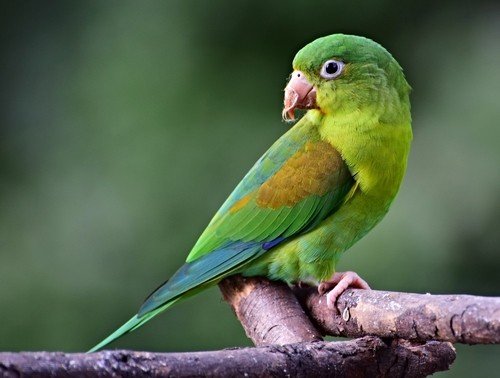
Orange-chinned Parakeet
The Orange-chinned Parakeet (*Brotogeris jugularis*) is a small, vibrant parrot species native to Central and South America. Known for its bright green plumage and distinctive orange chin patch, this parakeet plays a vital role in its ecosystem as a seed disperser. While not globally threatened, its populations face localized pressures from habitat loss and the pet trade. It is a popular, though sometimes noisy, companion bird. The species holds no particular cultural significance beyond its general appeal as a colorful and lively bird.
17-20 cm
Length
9-11 cm
Wingspan
Least Concern
Conservation Status
Distribution
The Orange-chinned Parakeet is found from southern Mexico to northern Colombia and western Venezuela. It has a broad altitudinal range, occurring from sea level up to around 1500 meters.
Lifespan
Typically 10-15 years in the wild; up to 20 years in captivity with proper care.
Orange-chinned Parakeet's Habitat
Habitat Types
Tropical lowland forests, Deciduous woodlands, Savannas, Mangrove swamps, Agricultural areas with scattered trees
Climate Zones
Tropical, Subtropical
Adaptations
Their strong beaks are adapted for cracking open a variety of seeds and nuts. Their zygodactyl feet (two toes pointing forward and two backward) provide excellent grip for climbing and manipulating food.
Variations
Two subspecies are generally recognized: *B. j. jugularis* (the nominate subspecies) and *B. j. exsul* (found in parts of Colombia and Venezuela). *B. j. exsul* is slightly larger and has a deeper orange chin patch.
Appearance
Breeding Plumage
No significant difference between breeding and non-breeding plumage.
Seasonal Feather Changes
No significant seasonal variations.
Sex Based Plumage Differences
Males and females are visually similar, although some sources suggest males may have a slightly brighter orange chin patch.
Notable Features
Bright green overall plumage, Distinctive orange patch on the chin, Yellowish-green underwing coverts, Dark brown eyes
Diet and Feeding
Primary Foods
Seeds, Fruits, Flowers, Nectar, Occasionally insects
Foraging Behavior
Orange-chinned Parakeets typically forage in flocks, moving through the canopy and along forest edges. They are agile climbers and often hang upside down to reach food.
Specializations
Their strong beaks and dexterous feet allow them to efficiently extract seeds from various fruits and pods.
Seasonal Diet Variations
Diet varies depending on the availability of fruits and seeds throughout the year. During periods of scarcity, they may consume more insects or nectar.
Behavior
Social Structure
Highly social birds, often found in flocks of 10-50 individuals, and sometimes larger aggregations outside the breeding season.
Communication
Loud, screeching calls, Chattering vocalizations, Contact calls to maintain flock cohesion
Migration
Generally non-migratory, although they may make local movements in response to food availability.
Territorial or Group Behaviors
During the breeding season, pairs become territorial and defend their nesting site. Outside of breeding, they are highly social and form large, noisy flocks.
Conservation
Threats
Habitat loss due to deforestation, Trapping for the pet trade (although less severe than for some other parrot species), Agricultural expansion
Protection Programs
CITES Appendix II (regulating international trade)
Local National Laws
Protected under various national wildlife laws in countries within its range.
Population Trend
Decreasing
Population Estimates
While the global population is not precisely quantified, it is believed to be relatively large, but declining due to habitat loss.
Interesting Facts
They are known for their playful behavior
Orange-chinned Parakeets are often observed engaging in playful interactions within their flocks, such as chasing each other and manipulating objects.
They can mimic sounds
While not as proficient as some larger parrots, they can learn to mimic a few words and sounds, especially in captivity.
They are important seed dispersers
By consuming fruits and seeds, they help to distribute seeds throughout their habitat, contributing to forest regeneration.
The Genus name 'Brotogeris' means 'having the voice of a human'
The name reflects on the bird's vocalization, which is often described as loud, noisy, and sometimes chatter-like.
Faqs about Orange-chinned Parakeet
Are Orange-chinned Parakeets good pets?
They can be good pets for experienced bird owners, but they are quite noisy and require a lot of attention and enrichment.
What is the lifespan of an Orange-chinned Parakeet?
They typically live 10-15 years in the wild, and up to 20 years in captivity.
Can Orange-chinned Parakeets talk?
They can mimic some sounds and words, but they are not known for their talking ability.
Are Orange-chinned Parakeets endangered?
No, they are listed as Least Concern by the IUCN, but their populations are facing pressures from habitat loss and the pet trade.
Copyright @ Nature Style Limited. All Rights Reserved.
 English
English